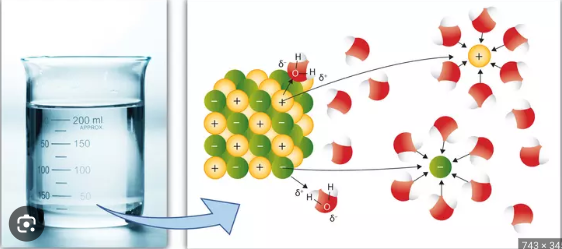1.1 Structure of Water and Hydrogen Bonding
1/14
There's no tags or description
Looks like no tags are added yet.
Name | Mastery | Learn | Test | Matching | Spaced |
|---|
No study sessions yet.
15 Terms
Properties of water
Most important: Polarity, High specific heat capacity, High heat of vaporization, Cohesion, Adhesion, Surface tension
Capillary action, density, universal solvent
Polarity
Polar covalent bonds created by unequal sharing of electrons between oxygen and hydrogen within the molecule of water
Caused in water by the difference in electronegativity between oxygen and hydrogen
Contributes to hydrogen bonding between and within biological molecules
allows for adhesion, cohesion, and surface tension
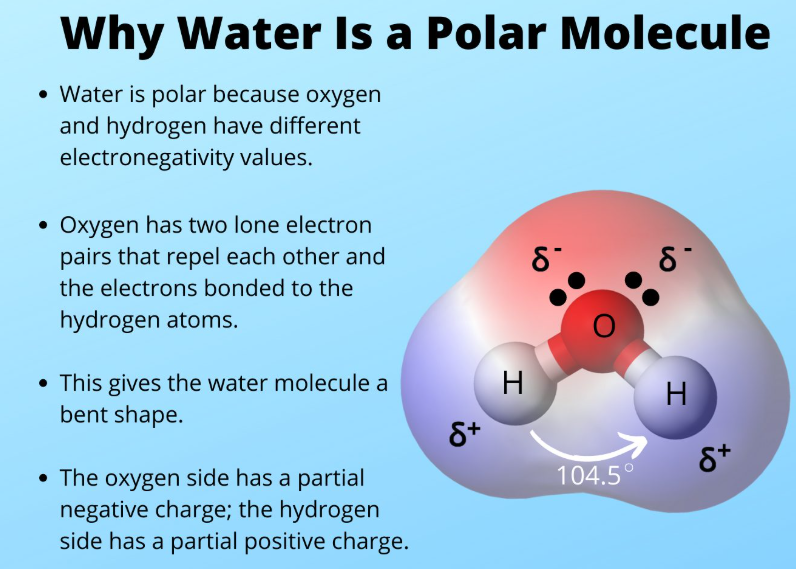
Electronegativity
the measure of an atom’s ability to attract electrons to itself
Large differences in electronegativity creates ionic bonds
Moderate differences create polar covalent bonds
Small differences create nonpolar covalent bonds
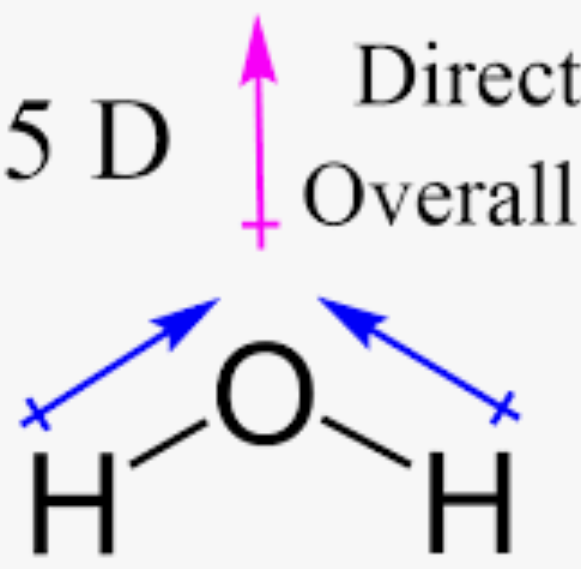
Hydrogen bonds
the partially positive hydrogen atom in one polar covalent molecule will be attracted to an electronegative atom in another polar covalent molecule
an intermolecular bond(bond that forms between molecules, not created, molecule to molecule, weak bond and forms quick which is good for us
Happens because when a hydrogen atom is bonded to an electronegative atom the electrons are not being shared equally between atoms(polar covalent bond), which causes the hydrogen to have a partial positive charge and the electronegative atom to have a partial negative charge
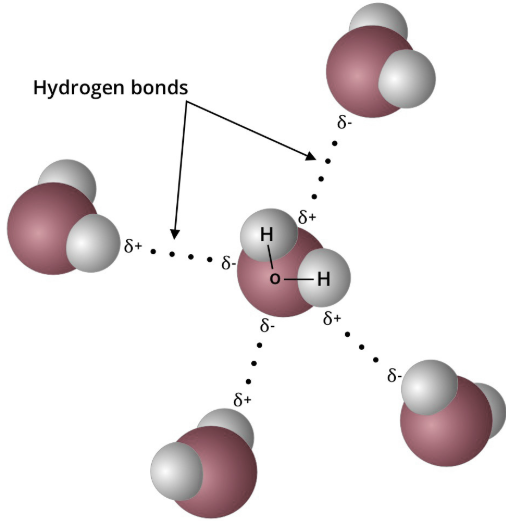
Covalent bonds
when two or more atoms share electrons
forms molecules and compounds
formed WITHIN the water molecule not between 2 water
2 types: nonpolar and polar
Nonpolar covalent
electrons are shared equally between two atoms
Hydrophobic
Water cannot dissolve non polar bonds

Polar covalent
electrons are not shared equally between two atoms
WITHIN the water molecule
Hydrophilic
Water’s Polarity allows it to dissolve ionic and polar compounds because the partially positive and partially negative ends of water interact with polar molecules and ions, helping disperse the molecules and ions in the solution
High specific heat capacity
H2O resists changes in temperature because the of hydrogen bonds
Heat must be absorbed to break hydrogen bonds, but heat is released when hydrogen bonds form
This moderates air temperature(large bodies of water can absorb heat in the daytime and release heat at night), stabilizes ocean temperature(benefits marine life), and organisms can resist changes in their own internal temperature
High heat of vaporization
Water requires a large amount of energy to evaporate due to strong hydrogen bonds
Evaporative cooling: as water molecules evaporate, the surface they evaporate from gets cooler
This moderates Earth’s climate, stabilizes temperature in lakes and ponds, prevents terrestrial organisms from overheating(ex sweating), and prevents leaves from becoming too warm in the sun
Adhesion
the attraction to other molecules that are polar or have charge (H2O to other molecules)
due to the polarity of H2O
Allows water to cling to the cell walls to resist the downward pull of gravity in plants
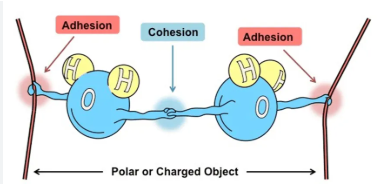
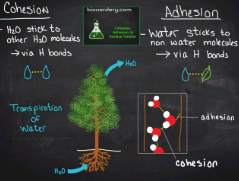
Cohesion
attraction of molecules for other molecules of the same kind (H2O to H2O)
Hydrogen bonds between H2O molecules hold them together and increase cohesive forces
Allows for the transport of water and nutrients against gravity in plants
allows for transpiration in plants
Responsible for surface tension
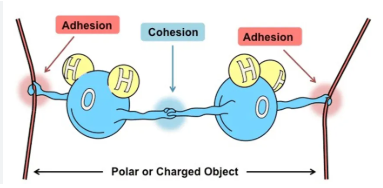
Surface tension
surface H2O molecules experience greater inward pull because there are no molecules above them to balance the forces
allows bugs to walk on water
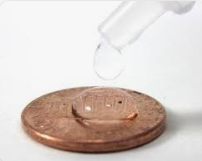
Capillary action
the upward movement of water due to the forces of cohesion, adhesion, and surface tension
occurs when adhesion is greater than cohesion
important for transport of water and nutrients in plants
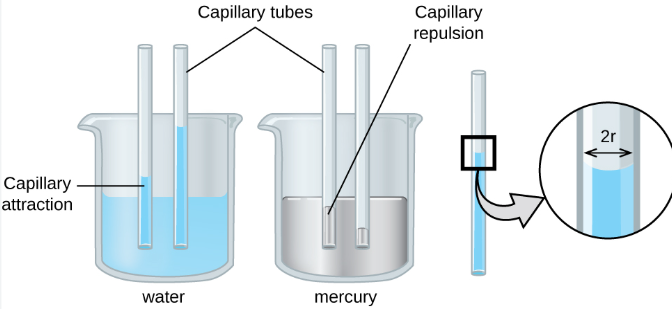
Density
as water solidifies it expands and becomes less dense
ice floats because it has low density
due to the hydrogen bonds
when cooled, H2O molecules move too slowly to break the bonds
Allows marine life to survive under floating ice sheets
Hydrogen bonds cause water molecules to form a crystalline structure
If ice was more dense, it wouldn’t float and would freeze from the bottom up
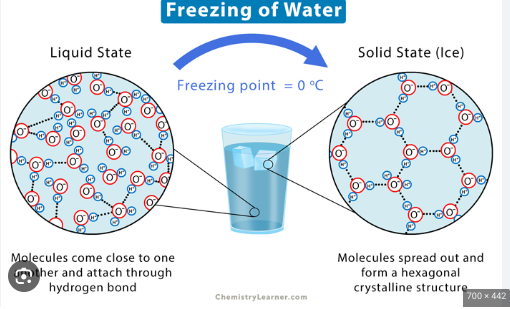
Universal solvent
Solvent is the dissolving agent in a solution
Water is considered a universal solvent because it can dissolve many substances
its polar molecules are attracted to ions and other polar molecules it can form hydrogen bonds with
the partially positive and partially negative ends of water interact with polar molecules and ions, helping disperse the molecules and ions in the solution
“like dissolves like”
water can interact with sugars or proteins containing many oxygen and hydrogen
water will form hydrogen bonds with the sugar or protein to dissolve it
dissolves ions
does NOT dissolve non polar molecules
